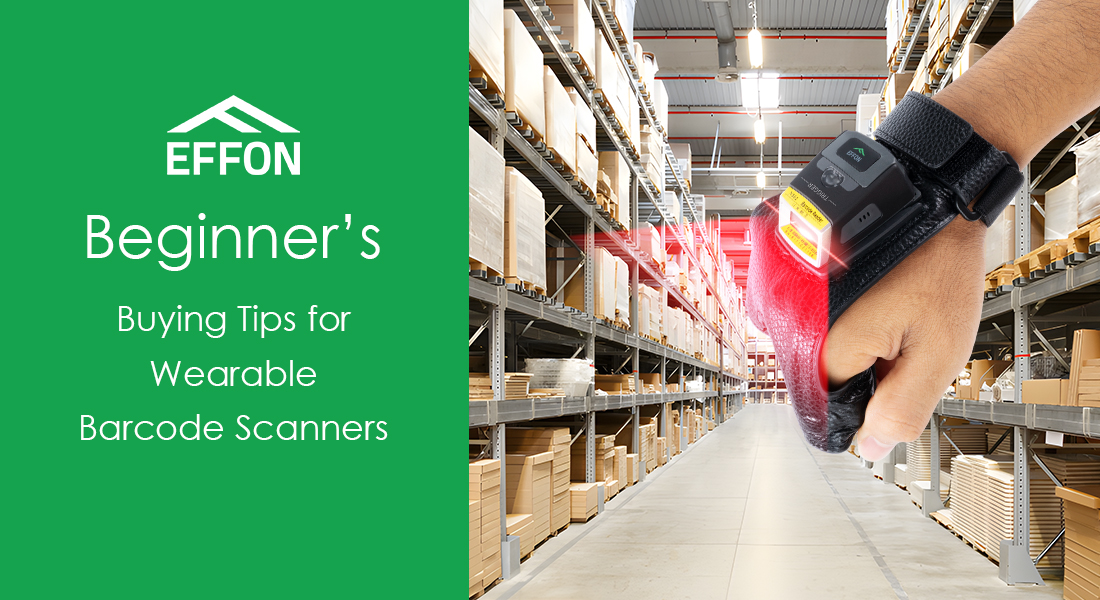
In warehouses, logistics centers, and retail operations, barcode scanners have become essential tools for efficient data capture. Traditional handheld scanners have already improved workflows, but they still require workers to pick up and put down the device repeatedly, which slows down productivity and increases fatigue.
With the rise of smart warehousing and logistics automation, wearable barcode scanners are quickly becoming the standard. By allowing workers to wear scanners on their fingers, gloves, or wrists, they can keep both hands free to pick, pack, or move items while scanning at the same time.
This article provides a comprehensive beginner’s guide with practical buying tips to help first-time buyers choose the right wearable scanner for their business.
Key Takeaways
Wearable barcode scanners free workers’ hands, boosting picking and packing efficiency.
Main types: ring, glove, wrist/arm-worn.
Buy based on: 1D/2D support, connectivity, battery life, ruggedness, ergonomics, software compatibility.
Applications: e-commerce warehouses, logistics, cold storage, manufacturing, retail.
ROI: 6–9 months, with 20–30% faster picking and 40% fewer errors.
Avoid mistakes: don’t buy only by price, check integration, always pilot test.
EFFON offers beginner-friendly models like T3, EF02, GS02, WT04.
What Is a Wearable Barcode Scanner?
A Wearable Barcode Scanner is a small device you can wear on your hand, finger, or wrist. It helps you scan barcodes quickly while keeping your hands free for other tasks. You might see these scanners in warehouses, stores, or even hospitals.
How It Works
You wear the scanner like a glove or a ring. When you need to scan a barcode, you point your hand at the code and press a button. The scanner reads the barcode and sends the information to a computer, tablet, or phone using Bluetooth. Some models give you feedback with lights, sounds, or a gentle vibration, so you know the scan worked.
Here’s a quick look at what a typical wearable scanner offers:
Feature/Aspect | Description |
|---|---|
Device Name | ProGlove MARK Basic wearable barcode scanner |
Scanning Range | Multi-range (4 in to 98 in), Standard range (4 in to 35 in) |
Design | Lightweight, compact, ergonomic (about 39g) |
Connectivity | Bluetooth Low Energy for easy pairing |
Feedback Mechanisms | Light, vibration, and sound to confirm scans |
Integration | Works with many warehouse and retail systems |
Battery Life | |
Use Cases | Warehouses, packaging, inventory, retail, picking |
Main Benefits for the Beginners
Tip: Using a wearable scanner can make your work faster and easier!
You can scan items without stopping your work, which saves time.
Hands-free use lets you carry, pick, or pack items while scanning.
Real-time data capture means fewer mistakes and better tracking.
Lightweight design keeps you comfortable, even during long shifts.
You can move around freely, which helps in big spaces like warehouses.
Many companies, like Amazon and DHL, use these scanners to speed up work and keep things safe.
In hospitals, wearable scanners help track medicine and supplies, making sure nothing gets lost.
Wireless connection keeps your data up to date with your company’s systems.
Types of Wearable Barcode Scanners
(1) Ring Barcode Scanners
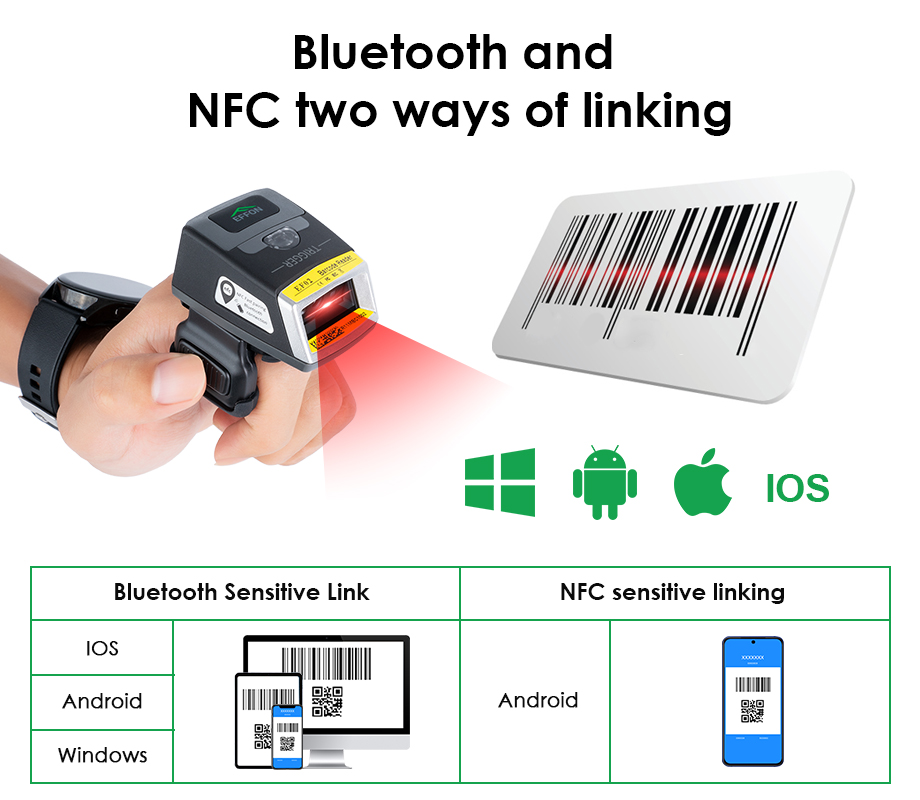
Worn on the finger like a ring.
180° rotation, adaptable for both left and right hands.
Rugged and durable, designed for harsh warehouse environments.
A hands-free scanning solution that boosts operator efficiency.
(2) Glove Barcode Scanners
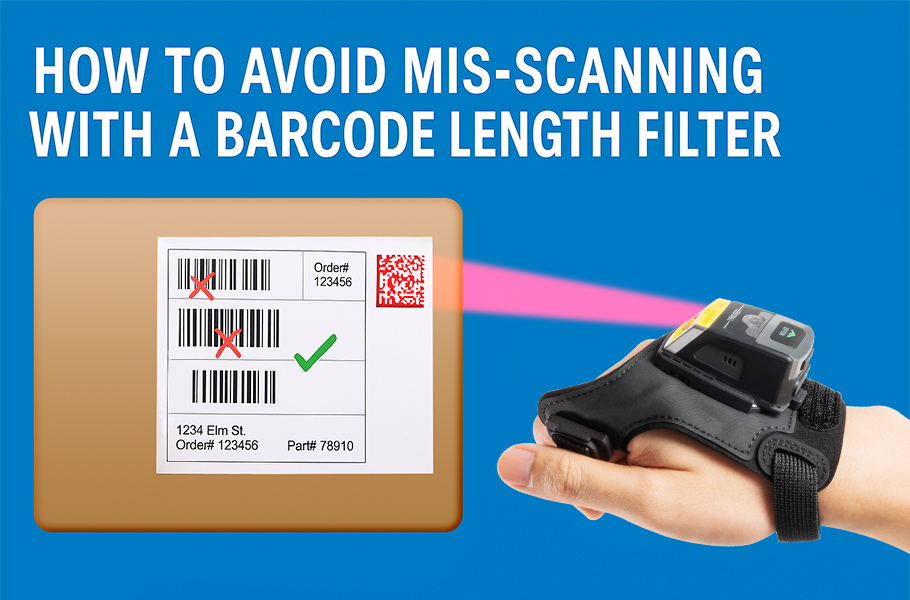
Integrated into a work glove, worn on the back of the hand.
More ergonomic and natural fit compared to ring scanners.
Available in both left-hand and right-hand versions.
The glove is washable, helping maintain hygiene and prevent cross-contamination.
(3) Wrist/Arm-Worn Computers
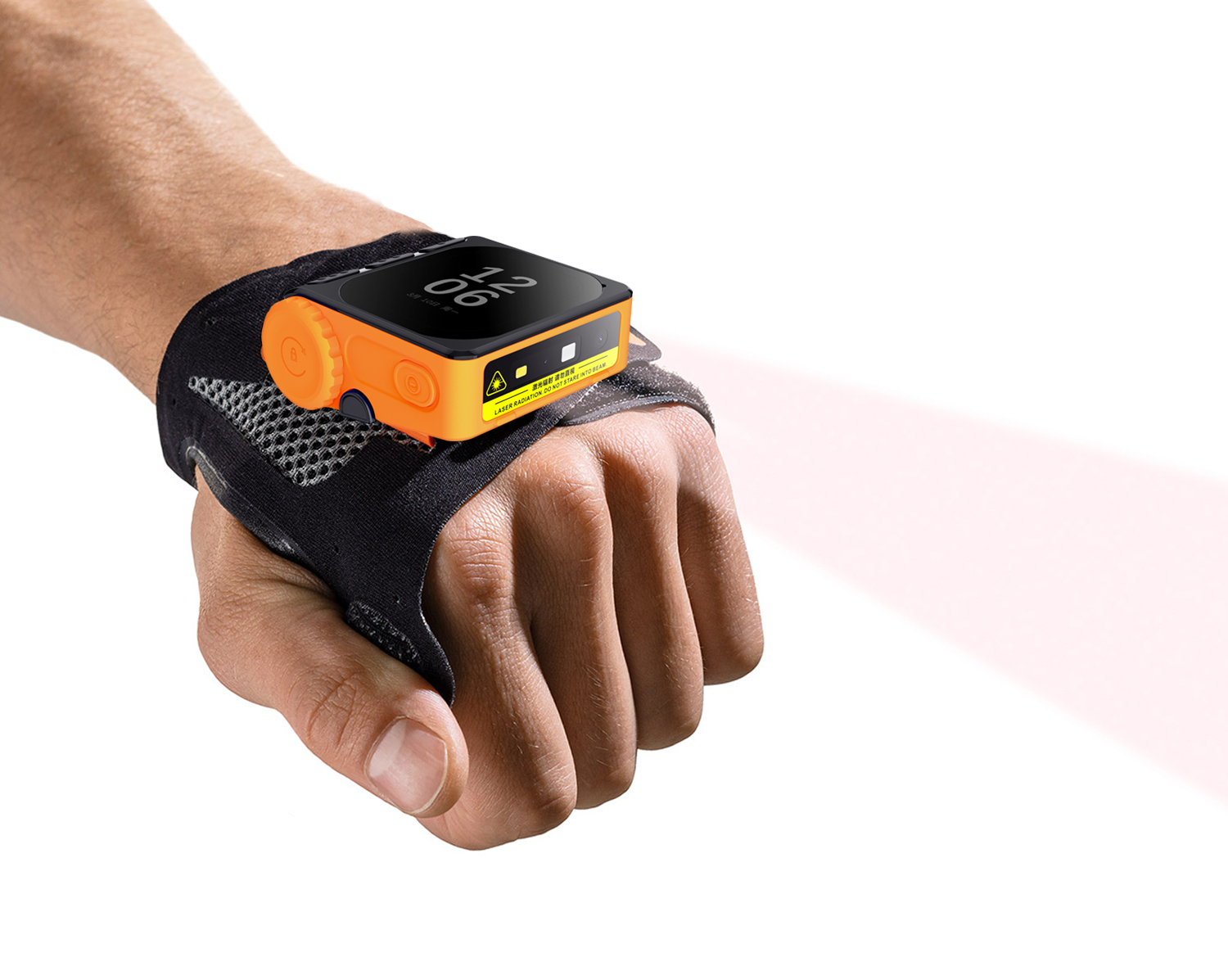
All-in-one device with integrated scanner and display screen.
Combines scanning and data transmission in real time.
Ergonomic glove-style design for comfortable use.
Cost-saving solution: one device works as both a scanner and a mobile computer.
Beginner’s Guide for Wearable Barcode Scanners
New to wearable scanners? Here’s what you need to know before placing your first order.
1. Match the Right Scanner to Your Use Case
You want a scanner that fits your daily tasks. If you work in a warehouse, you might pick, pack, or check inventory all day. A Wearable Barcode Scanner lets you scan items while keeping your hands free. This makes your job faster and easier. You do not have to stop and pick up a device every time you need to scan.
Workers in logistics, recycling, and telecommunications use wearable scanners to boost speed and cut down on mistakes.
Real-time data capture helps you see inventory changes right away.
You can avoid errors because you do not have to type in numbers by hand.
Good ergonomics mean less strain and less tiredness at the end of your shift.
Tip: Match your scanner to your workflow. If you move a lot or need both hands, a wearable model can save you time and energy.
Indoor vs. Outdoor Use
Think about where you will use your scanner. Indoors, you may face dust, bright lights, or crowded spaces. Outdoors, you might deal with rain, heat, or cold. Some scanners work better in tough conditions. Look for models that handle extreme temperatures, humidity, and accidental drops.
Military and recycling jobs often need scanners that survive rough use.
Entertainment workers need quick, reliable scans in busy places.
Good motion tolerance helps when you scan moving items or work on the go.
Choose a scanner that matches your environment. This helps you get the best results and keeps your scanner working longer.
2. Key Features
Scanning Range
You want a scanner that works at the right distance for your job. Some scanners read barcodes up close, while others reach several feet away. If you work in a warehouse, you might need to scan items on high shelves or far pallets. The scan range tells you how close or far you can be from the barcode and still get a good read.
Here’s a quick table to help you understand the main scanning range metrics:
Metric | Description |
|---|---|
Scan Depth of Field | The closest and farthest distances where scanning works well. |
Resolution (Minimal Bar Width) | The smallest barcode line the scanner can read. |
Scan Width | How wide a barcode can be read at a certain distance. |
Scan Speed | How fast the scanner reads barcodes. |
First-Time Recognition Rate | How often the scanner reads a barcode right away. |
Error Rate | How often the scanner makes a mistake. |
If you use a ring scanner, you might notice it works best at short distances. Smart gloves and handheld scanners often reach farther. Think about how far you need to scan and pick a model that matches your daily tasks.
Tip: Always check the scan range before you buy. The right range can save you time and effort.
Accuracy
Accuracy matters a lot. You want your Wearable Barcode Scanner to read codes right the first time. High accuracy means fewer mistakes and less time fixing errors. In warehouses, most companies expect at least 99% accuracy. Some scanners, like ProGlove, help reduce errors by 33%. Workers also say they like using these scanners, with a 95% approval rating.
Here’s a chart that shows how wearable scanners help with accuracy and speed:
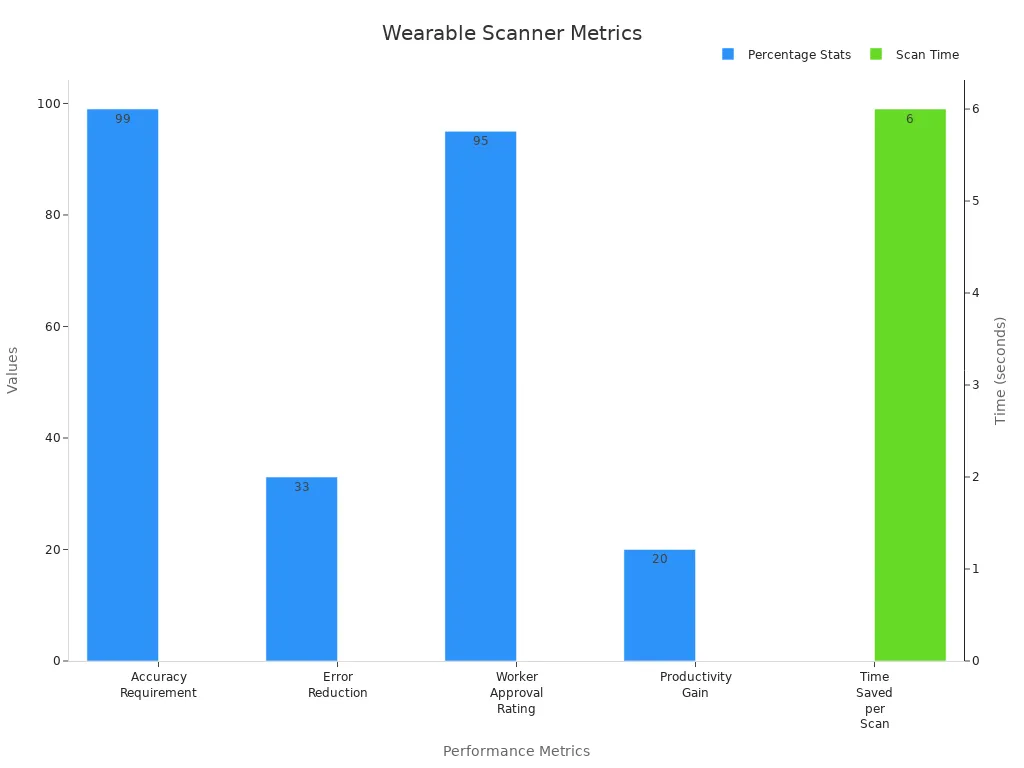
Automated scanning can cut human errors by up to 50%.
You get real-time updates, so your inventory stays correct.
Each scan can save you about 6 seconds compared to old methods.
Note: Fewer errors mean less wasted time and happier customers.
Battery Life
You do not want your scanner to die in the middle of a shift. Battery life tells you how long the scanner will last before you need to charge it. Some models last all day, while others need charging more often. If you scan hundreds of items each day, look for a scanner that can handle heavy use.
Check how many scans you get per charge.
Some scanners last for thousands of scans before needing a recharge.
Quick charging can help if you have short breaks.
Tip: Always ask about battery life and charging time before you buy.
Connectivity
Your scanner needs to talk to your computer, tablet, or phone. Most wearable scanners use Bluetooth or Wi-Fi. Bluetooth is great for short distances and easy pairing. Wi-Fi works well if you need to send data over a bigger area, like a large warehouse.
For example, the Datalogic CODiScan supports Bluetooth 5.2 LE and Wi-Fi (IEEE 802.11b/g/n). This means you can connect to many different devices and networks. If you move around a lot, Bluetooth might be enough. If you need to send lots of data or work in a big space, Wi-Fi could be better.
Note: Make sure your scanner works with your devices and software.
Durability
You want a scanner that can handle drops, bumps, and tough conditions. If you work in a warehouse or outdoors, your scanner might get dropped or knocked around. Look for models with strong cases and good protection against dust and water.
Some scanners work in hot, cold, or wet places.
Check if the scanner has a high drop rating or is water-resistant.
Durable scanners last longer and save you money in the long run.
Tip: Pick a scanner built for your work environment. Durability keeps you working without worry.
3. Comfort and Usability
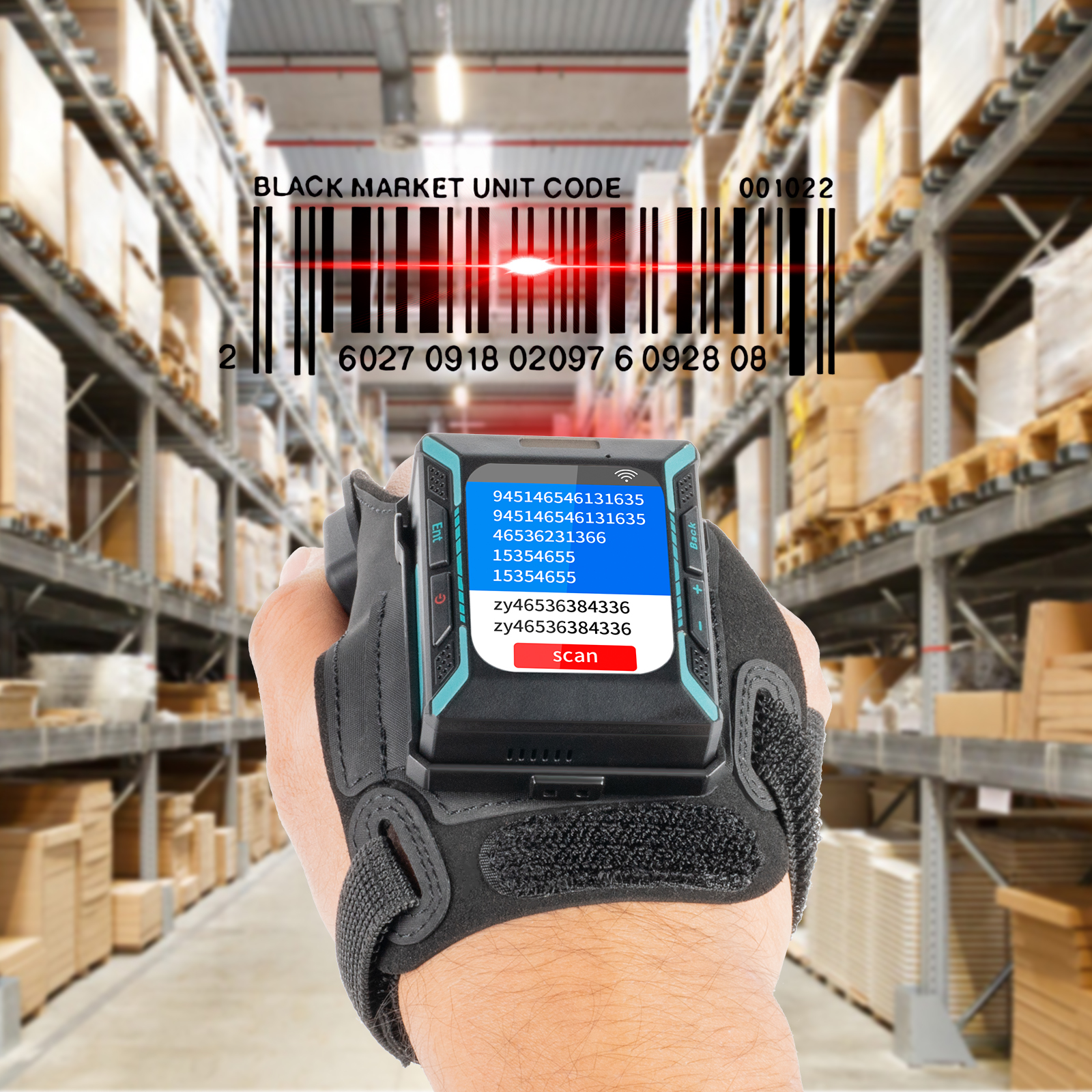
Ergonomics
You want a scanner that feels good all day. Many wearable barcode scanners use lightweight designs and spread the weight evenly. This helps you avoid sore hands and tired arms. Hands-free operation lets you do more than one thing at a time, so you can pick, pack, or move items without stopping to grab a scanner.
Lightweight scanners reduce strain and fatigue.
Even weight distribution keeps your hand and wrist comfortable.
Ergonomic shapes lower pressure points and muscle stress.
Some models have a low center of gravity, so they feel stable and secure.
Integrated glove scanners let you scan with both hands free, making your job easier.
Tip: Look for scanners with ergonomic certifications or user-friendly designs. Your comfort matters, especially during long shifts!
Wearing Styles
You can choose from several wearing styles to match your job and comfort needs. Each style offers its own benefits:
Wearing Style | Description | Ergonomic Benefit |
|---|---|---|
Holster | Clips to your belt for quick access | Secure and easy to reach |
Over-the-shoulder strap | Lets you move freely while carrying the scanner | Spreads weight, boosts mobility |
Two-handed grip | Supports both hands for longer use | Less hand fatigue |
Worn on your finger, keeps hands free | Hands-free and convenient | |
Lanyard neckwear | Hangs around your neck for easy movement | Lightweight and always accessible |
Many scanners let you switch between styles. You might use a ring mount for picking, then switch to a holster for packing. Wireless and lightweight designs help you stay comfortable, even if you scan all day.
Adjustability
You need a scanner that fits you just right. Some models come in different glove sizes, from extra small to extra large. You can wear them over your own gloves or directly on your hand. Velcro straps make it easy to put on or take off the scanner, even during short breaks. Some designs let you keep your own hand wrap for better hygiene. Others use a low-profile back-of-hand mount, so your palm stays free and you can move your hand easily. These features help you stay comfortable and work faster, no matter your hand size or the task at hand.
Performance
Scanning Speed
You want to move fast at work. A Wearable Barcode Scanner helps you do just that. With hands-free scanning, you can pick up items and scan them in one smooth motion. In real-world tests, companies like BMW saw order-picking speed jump by 30% after switching to glove scanners. Workers at ASICS scanned thousands of items each day with less effort and more comfort. High scan rates, like 45 scans per second, make these scanners perfect for busy places such as warehouses and stores. You save time and avoid mistakes because you do not have to stop and grab a device.
Tip: Faster scanning means you finish your tasks sooner and with less stress.
Wearable Barcode Scanner Compatibility
You need your scanner to work with your systems. Compatibility means your scanner connects easily to your computers, tablets, or phones. Most scanners use Bluetooth or Wi-Fi. Some connect with USB or NFC. Check if your scanner reads both 1D and 2D barcodes. Some jobs need QR codes or DataMatrix codes for more data. Here’s a quick look at what to check:
Compatibility Aspect | What to Look For |
|---|---|
Interface Types | Bluetooth, Wi-Fi, USB, NFC |
Barcode Types | 1D, 2D (QR, DataMatrix) |
Device Support | Works with your POS, EHR, or ERP system |
Note: Always test your scanner with your software before you buy.
Integration
You want your scanner to fit right into your workflow. Many scanners come with apps or software that help you connect to your company’s systems. For example, in hospitals, scanners link to patient records. In logistics, they update package tracking in real time. Some scanners use cloud services for instant data sharing. Others work with mobile device management tools to keep everything secure. Here are some real-world uses:
Transit workers scan tickets with smartwatches.
Delivery drivers track packages on the go.
Easy integration means you spend less time setting up and more time getting work done.
Budget and Value
Setting a Realistic Budget
Start by thinking about what you really need. If you run a small shop, you might not need the most advanced scanner. If you work in a busy warehouse, you may want more features. Market research shows that many small businesses worry about high upfront costs, with 41% saying it’s a big challenge. You can find budget guides and pricing reports that help you compare options and see what fits your needs. Here’s a quick look at different scanner types and where they work best:
Scanner Type | Key Benefit | Typical Use Case | Example Model |
|---|---|---|---|
Handheld Scanners | Portable and lightweight | Small businesses, retail | Tera HW0009 |
Fixed Scanners | Always ready in one spot | POS, assembly lines | Tera 3100 |
Wearable Scanners | Hands-free, boosts efficiency | Warehouses, fast inventory | Tera HW0010 |
Mobile Device Scanners | Flexible, easy to use | Temporary or small-scale scanning | Tera 0013 |
Tip: Match your scanner to your workflow and budget. Don’t pay for features you won’t use.
Cost vs. Features
Prices can vary a lot. Some models cost a few hundred dollars, while others go over a thousand. Take a look at this price range:
Model Name | Approximate MSRP Price (USD) |
|---|---|
Zebra CS6080 Healthcare Barcode Scanner | $880.00 – $1,045.00 |
Zebra RS2100 Barcode Scanner | $544.50 |
Zebra RS6100 Barcode Scanner | $1,291.76 – $1,604.25 |
Honeywell 8675i Barcode Scanner | $1,114.03 – $1,375.45 |
Zebra RS5100 Barcode Scanner (Single Trigger) | $1,193.70 – $1,345.58 |
Unitech MS912 Barcode Scanner (Cordless) | $234.00 |
Think about which features matter most. Long-range scanning, extra durability, or special feedback can raise the price. Sometimes, spending more upfront saves money later by cutting down on mistakes and boosting speed. Reports show that using the right scanner can give you a 40% return on investment and save up to 25% on labor and inventory errors.
Trial Before Purchase
Always ask for a trial before you buy. A trial lets you see if the scanner feels right and works with your systems. You can test comfort, speed, and how well it fits your daily tasks. This step helps you avoid surprises and makes sure you get the best value for your money.
Note: Try before you buy. It’s the best way to know if a scanner is right for you.
Pros and Cons
Advantages
When you use a wearable barcode scanner, you get a lot of benefits that make your work easier and faster. Here’s a quick table to show you some of the main advantages:
Aspect | Benefits |
|---|---|
Operation Mode | Hands-free scanning boosts your efficiency and lets you multitask |
Speed | Picking speed can jump by 30–50% in busy or cold environments |
Comfort | Lightweight design keeps you comfortable during long shifts |
Environmental Suitability | Built to handle moisture, bumps, and even freezing temperatures |
Usability | Works well with gloves and supports high-frequency scanning |
Connectivity | Wireless Bluetooth makes data transfer quick and easy |
Integration | Connects smoothly with warehouse and business software |
You’ll notice these scanners let you move freely, which is great if you work in a big warehouse. Many users say they love being able to scan and carry items at the same time. You can connect your scanner to your system using Bluetooth, Wi-Fi, or USB. The rugged design means you don’t have to worry about drops or dust. Long battery life keeps you working without stopping to recharge.
Tip: Wearable scanners help you finish tasks faster and with less effort. 😊
Drawbacks
While wearable barcode scanners offer many perks, you should know about some challenges. In some workplaces, managers use the data from these scanners to track how fast you scan and how many mistakes you make. Sometimes, you might see your productivity score on a leaderboard or get alerts to work faster. This can make you feel stressed or pressured, especially if you worry about making mistakes. Some workers feel it’s not fair if the system penalizes them for things outside their control.
Note: The scanner itself works well, but how your company uses the data can affect your work experience. Always ask how your workplace handles performance tracking before you start using a new device.
Application Scenarios
1. E-Commerce Warehouses
Hands-free picking increases efficiency by 20–30%.
2. Logistics & Distribution Centers
Scan packages while moving items, avoiding repetitive device handling.
3. Cold Storage
Wearable scanners with low-temperature batteries operate reliably in freezing conditions.
4. Manufacturing
Track components and ensure traceability on assembly lines.
5. Retail Stores
Enable quick stock replenishment and backroom inventory checks.
Quick Checklist
Key Questions
Before you buy a wearable barcode scanner, ask yourself these questions. They help you check the most important features and avoid surprises later.
How fast does the scanner read different types of barcodes? Test the recognition time to see if it keeps up with your pace.
Does the scanner work with your current systems? Check the data interfaces and communication protocols to make sure you can connect easily.
How does the scanner feel in your hand? Try it out for grip comfort, weight, and ease of use. Lightweight and wearable designs usually feel best.
Can you upgrade the scanner later? Look for modular designs and support for new barcode formats or firmware updates.
What is the total cost over time? Think about maintenance, durability, and how well it stands up to dust or water.
Is your data safe? Make sure the scanner uses encrypted transmission and comes from a supplier with good support.
If the scanner you bought is glove scanner, please don’t forget to ask if the gloves are washable? Because it’s related to the Personal hygiene.
Tip: A quick checklist like this can save you time and help you make a smart choice.
Final Tips
Pick a scanner with an ergonomic design, like a wrist strap or low center of gravity, to keep your hand comfortable.
Choose wireless options such as Bluetooth or Wi-Fi for fast and stable data transfer.
Go for rugged models with high IP ratings if you work in tough places.
Make sure the scanner works with your devices and software, like Windows, Android, or iOS.
Select the wearing style—ring, wristband, or glove—that fits your job best.
Look for scanners that meet industry standards and have features like programmable LEDs for scan confirmation.
Adjustable mounts help different users stay comfortable.
Balance the price with the features you need. Don’t pay for extras you won’t use.
Plug-and-play models are easy to set up, which is great if you’re just starting out.
Remember: The right scanner makes your work easier, faster, and more comfortable!
You want the right scanner for your job. Think about comfort, how it fits your workflow, and if it works with your devices. Set a budget that makes sense for you. Always ask for a trial. Make a smart choice and feel confident with your new tool!
FAQ
How do you charge a wearable barcode scanner?
Most scanners use a USB cable or a charging dock. Just plug it in when you finish your shift. Charging usually takes a few hours.
Can you use a wearable scanner with gloves?
Yes, many models fit over work gloves. You can scan without taking your gloves off. Always check the size and fit before you buy.
What should you do if your scanner stops working?
Try turning it off and on again.
Check the battery and connections.
If it still does not work, contact support for help.

